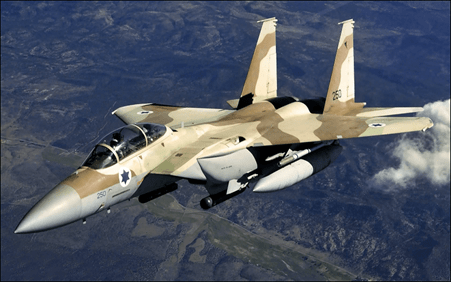The Perfectly Timed Leak
The Israelis struck Iran from the air on the night of October 25. Media and analysts have been studying the strike in isolation and often drawing the wrong conclusions. The strike must be evaluated in conjunction with a leak of classified American intelligence information.
On October 17, a top-secret document from the National Security Agency (NSA) and the National Geospatial-Intelligence Agency was published on Telegram by an Iran-linked channel. The document was seized upon by analysts the world over. The consensus was that it was genuine. The ongoing FBI investigation has identified a suspected leaker, but that is another story.
An image of the document appears in this post on Twitter-X:
The document outlined American surveillance of Israeli preparations to attack Iran. It detailed the weapons systems involved and the numbers to be deployed. The document did not explicitly disclose the timing of the attack or its intended targets.
However, knowledge of the number and type of weapons systems deployed does give an analyst a good idea of the intended targets. Especially when combined with the public utterances of senior Israeli officials.
Following the Iranian attack on Israel of October 1st, speculation swirled about the timing of Israeli retaliation. The Iranian missile attack had overwhelmed Israeli air defenses and prompted bellicose vows of immediate and harsh retribution.
Days dragged into weeks, and the Israeli attack did not come. The Iranian attack proved that the Islamic Republic could hit targets in Israel with precision. Of more concern, the Islamic Republic was threatening to go nuclear. Some analysts, including this writer, consider it likely that Iran is already in possession of gun-type A-Bombs.
A violent response by Israel would certainly lead to a more violent response by Iran, and rapid escalation to regional war. If the conflict did not go nuclear. The Israelis and their American allies were intimidated by the October 1st Iranian attack because it proved that swarms of Iranian IRBMs could penetrate their air defense.
Politics played a role (as it always does). The American presidential election was scheduled for November 5. The US administration had two goals: 1) prevent an uncontrolled escalation, and 2) delay the Israeli attack until after the election. The last thing the Democrat administration wanted was to have to deal with a war in the Middle East during campaign season.
With less than three weeks to go until the election, the document leak wrecked the Israelis’ plans.
The Israelis were incandescent.
The Foiled Plan
Two weapons systems were identified in the leaked document: 1) The Golden Horizon, a secret, long-range air-launched ballistic missile (ALBM), and 2) ROCKS, a shorter-range ALBM. Golden Horizon has a range of 1,200 miles. ROCKS about 400 miles. Golden Horizon is a new weapon with truly formidable specifications. The leak exposed its existence to the light of day.
The 1,200 mile distance from Israel to Iran was a major hurdle. Aircraft, with bombs, are able to deliver much heavier payloads than missiles, and Israel does not have as many missiles as Iran. Israel’s vaunted air force could not reach Iran without mid-air refueling. To complicate matters, the Organization of Gulf States met in Doha and declared their neutrality in the conflict between Israel and Iran. They agreed to not allow Israel and the United States to refuel in their airspace.
Analysis of the leaked document immediately suggested the Israeli plan. In the event, speculation turned out to be very close to what actually transpired, with a few major differences. First, shorter-range missiles would be used to destroy Iranian radar sites in Syria and Iran. Destruction of radar sites was an effort to create holes in Iran’s air defense. Second, the Israeli strike package would penetrate Syrian airspace, fly east, and launch their long-range ALBMs over Western Iraq. The strike package would then turn around and go home. The ALBMs would drop their boosters and continue east to their targets.
It must be pointed out that Russian radars in Syria, immune to Israeli attack, are able to track every single aircraft that lifts off from Israel. Destroying Iranian radars did nothing to prevent Russian radars and AWACS from detecting the Israeli strike package and passing target cueing data to the Iranians, including S-400 batteries in Iran manned by Russians.
Figure 2. Alternative Israeli Strike Package routes to attack Iran
The question was, what were the targets?
Natural high-value targets are Iran’s nuclear sites and oil production facilities. Striking those sites would lead to escalation on a scale extending from catastrophic to apocalyptic. Somewhere approximately in that range. Striking oil facilities would result in Iran’s closure of the Straits of Hormuz and $200-plus oil in the two weeks leading to a US presidential election. It would also result in a rain of Iranian IRBMs on Israel’s energy infrastructure and possibly its water purification and port facilities. Iran would blast Israel into the stone age.
Most of Iran’s key nuclear sites are deep underground. At least a quarter of a mile. It is questionable whether they can be destroyed by conventional weapons. If Israel used nuclear weapons to strike underground nuclear targets, and Iran had even simple A-Bombs, the destruction of Tel-Aviv and Haifa were guaranteed. Even if Iran’s attack was purely conventional, Iran would turn Israel into a smoking parking lot with conventional missiles.
Target selection was a fraught negotiation. The United States was adamant that Israel should not strike nuclear or oil facilities. But what could Israel strike with its limited supply of missiles? Iran’s military assets were scattered over a wide area, well protected by air defense, and usually underground. Iran has numerous “missile cities” and at least three missile factories built at least 500 meters below the surface.
We don’t know for sure what Israel’s preferred target was, but it is reasonable to conclude the Israelis were planning a decapitation strike. They had just come off a successful run of high-profile assassinations of senior Hamas and Hezbollah targets. They killed these men by striking in major cities like Damascus, Beirut, and Tehran itself.
Many analysts were anticipating a decapitation strike to take out Supreme Leader Ayatollah Khamenei, President Masoud Pezeshkian, and IRGC Commander Hossein Salami. The strikes would also take out as many of the senior civilian and IRGC leadership as possible.
Such a target deck suited Israel’s capabilities and modus operandi. It also suited a weapons profile that consisted of 40 missiles to take out radar sites and only 16 long-range missiles to do the dirty business.
There was, of course, a political dimension. If Israel decapitated Iran before the election, the war would begin before the new US president was selected. Whichever candidate won, the new president of the United States would inherit a war in which support of Israel was not a question.
Israel was counting on killing Iran’s senior leadership. Israel had to strike the first blow and make it count.
The document leak foiled the Israeli plan.
The Attack
Once the US intelligence leaked, everyone had an idea what the Israeli plan would entail. There was no Plan B. The Iranians would have immediately moved their mobile radars, or installed backup installations. Russian satellite, electronic warfare, and radar assets would be alerted. Air defense systems would be tailored to the anticipated threats. Warning the Iranians about ROCKS and Golden Horizon was an unbelievable gift. Iranian leadership targets would be relocated and their schedules randomized.
Initially, Israel cancelled the attack. But timing was critical for them. The Israeli people were impatient. All that bellicose rhetoric and the leadership was dragging its feet! In fact, the whole world was waiting on them. They decided to go with a half-baked plan.
In the event, the Israelis did not launch a decapitation strike. They struck “military” targets. Air defense radars, a missile fuel production plant, and two Iranian bases. Their target deck was thoroughly unremarkable. There were only four Iranian casualties. All were military, associated with a strike on a radar installation.
This video shows Iranian air defense intercepting Israeli threats. In the video, a group of threats is visible traveling from right to left, engaged by AD. It looks like all are destroyed in flight.
First wave, Tehran – AD engaging threats
Apart from one or two explosions on the ground, Iran was devoid of pyrotechnics. There was air defense activity to be sure. The air war over Baghdad in ’91 looked more spectacular. It looked like most incoming threats were shot down. There were a few flashes in the mostly black sky. Iranian airports were not affected.
The attack was over in a couple of hours.
People stayed up all night watching for reports (this writer wanted to see the show). They were using words like underwhelming, weak, tepid, feeble, and flaccid.
Figure 3. Tehran early morning of October 26 after the October 25-26 attack.
Israel claimed they used 100 aircraft in the strike. The 56 missiles in the leaked report imply a strike package of fewer than 40 planes, including 3 tankers and an AWACS. The missiles used were too big for F-35s, and were probably delivered by F-15i’s (see Figure 1). The Golden Horizon, in fact, was specifically designed for the F-15i (the evolution of this weapon will be discussed in a forthcoming article). The planes did not enter Iranian airspace and turned back over Iraq. Mass media reports that refer to “Israeli warplanes operating freely over Iran” are, shall we say, highly suspect. Mass media has also been recycling video of the October 1 strike by Iran on Israel, presumably because it looks more dramatic.
The real question is the effectiveness of Iranian and Russian air defense against Israeli ALBMs. The video above shows interceptions, but a few missiles got through. The Israelis damaged one of about fifteen above-ground solid-fuel mixing facilities. These buildings are easily identified by the high sand berms that surround them. The berms prevent the explosion of one structure from damaging the others. The other fourteen structures were not damaged. Indeed, many of the China-produced mixing machines might already have been installed in the vast galleries of underground factories 500 meters deep. While replacement of any damaged machinery from the west is impossible, China will be happy to supply more.
Israel attacked with 16 Golden Horizons. To take out all the solid fuel mixing structures, protected by berms, they would have had to use at least 15 and probably more. That’s on one base. The number 16 was sized for the abortive decapitation strike. This strike was launched in a hurry because the original plan was spoiled. The loadout was spread around.
Talking heads are reporting the destruction of “all of Iran’s S-300 missiles.” This is probably incorrect. The launchers and the radars are physically separated, and the 40 short-range missiles in the strike package were certainly targeted at the radars. It’s the radars that are important to clear a strike corridor, not the missiles. Two missiles per target means twenty radars. This is why Israel reports that “more than 20 targets were attacked”, while Iran says two bases and a factory were attacked. It’s a difference of emphasis. The radars were probably attacked with ROCKS, the bases by Golden Horizons. There is no mention of Russian S-400 sites being attacked. Israel was careful not to kill Russians. But that means Russian radars and air defense all the way from Syria to Iran are still effective. It is also likely that most of the S-300 radars were moved around after the NSA document leak. Everything of value that could be moved in the week following the leak would have been moved.
Here’s a good analogy. We have at least two THAAD radars in Israel. These are so good, so powerful, a human standing in front of them will burn alive. If Iran destroys all of Israel’s Iron Dome and Arrow radars, but leaves the THAAD radars alone because they don’t want to kill Americans, it won’t do them any good. Same deal for Iran and Russian radars.
We know we have a popular resistance movement in Iran, all of whom have camera phones. They have never had trouble getting video of their protests out of Iran in real time. We have seen no video of Israeli missile strikes. The paucity of evidence suggests Iranian air defense was mostly successful. This has led some mass media outlets and Israeli sources to recycle old images for dramatic effect. The Times of India has worked to verify these claims and identified “fake news” images of Israeli missile hits.
Iran admits to taking some damage and has stated that the significance of the attack should neither be exaggerated nor downplayed. Iranian officials will determine how to respond. For their part, the Israelis are playing up the strike as much as they can and warning Iran not to respond.
There are two questions: 1) will Iran respond, and 2) will Israel revisit their original plan?”
About the Author
Cameron Curtis
You may contact the author at: [email protected]
Cameron Curtis has spent thirty years in the financial markets as a trader and risk manager. He was on the trade floor when Saddam’s tanks rolled into Kuwait, when the air wars opened over Baghdad and Belgrade, and when the financial crisis swallowed the world. He’s studied military affairs and warfare all his adult life. His popular Breed series of military adventure thrillers are admired for combining deep expertise with propulsive action. The premises are realistic, the stories adrenaline-fuelled and emotionally engaging. Check out the books here: Cameron Curtis’s Amazon Page
**Hey folks, just realized that the Christmas Season is right about the corner and any of the Breed books would make fantastic gifts. Something to keep in mind. — GDM



